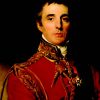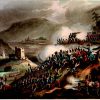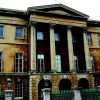It is tempting to speculate that Wellington Square was deliberately set aside from the other squares in Adelaide because the Duke of Wellington was somehow different from all those who were in contention. Unlike the squares in the city proper, which were reserved for those close to the colonisation scheme and some circumspect deference to royalty, the lone square in North Adelaide almost demanded special, albeit removed status.
The ‘Iron Duke’, as Wellington came to be known, neatly falls into such a category. The truth, however, is probably less romantic. The Adelaide plan evolved on site during the surveying process and according to the topography on either side of the River Torrens. When the streets north of the river were surveyed, their special configuration suggested the need for at least one square which was conveniently named after the Duke. In a nice touch of serendipity, his iconic status, the philosophical divide between him and the colonial theorists, and the obvious political and personal differences he had with most of the Street Naming Committee almost begged that he be named but set aside. Nevertheless, he needed to be acknowledged, for under the gentle but passionate persuasion of Robert Gouger, it was Wellington’s vote and the weight of authority he carried in the House of Lords which ensured the passage of the South Australia Bill into law. To memorialise Wellington at a distance from the centre of Adelaide was a neat conclusion.
Wellington’s influence over world events during the first half of the nineteenth century elevated him to cult status throughout the British Empire and the aura lingers in Britain and Europe, even to this day. Wellington’s ultimate victory over the French and the permanent humiliation of Napoleon assured him of an immortality etched in stone. Dozens of artists, painters and cartoonists sought to capture his portrait. Innumerable writers and poets rushed to eulogise him. More than sixty serious portraits of him are known to be in existence and his visage now graces the walls of galleries and homes throughout the western world. The best of them capture a frank, decisive, quick and hard-working warrior exuding a certain vanity and arrogance. Looming from the canvas or from the page of a book, he is best revealed as ‘stern, direct and downright; abrupt with people; extremely outspoken; well-organized … attentive to detail; keen to keep his emotions firmly under control … and with an inordinate amount of sangfroid’. Everyone, it would appear, is in agreement about the Duke of Wellington!
The question arises as to how and why such an entrenched opponent of electoral reform could be given such prominence in Adelaide’s ‘pantheon of dissent’. After all, he was such an encrusted Tory. He had resisted parliamentary reform at every turn and took a hard line on so many issues that the mob often rose up against him, sometimes violently attacking his person and his house in London. In 1831 ‘a tumultuous crowd surged around Apsley House and could only be dispersed by the firing of a gun over their heads’. This event led to intense fortification, and personal security guards were placed around his home.
In 1834 the House of Commons was enjoying an almost unprecedented rush of reformist legislation during the ‘honeymoon period’ of the new Reform Parliament. There were as many as 160 mostly new members in the Commons who could be described as radicals, and in a powerful coalition with the Whigs they were feasting on a raft of social and economic legislation, such as the parliament had rarely seen before. The South Australia Act, generally described as folly by Tory supporters in the press and elsewhere, was one such initiative. It passed the Lower House with ease. The vote was 72 for and 2 against. However, to have carriage into law it needed majority support in the Tory- dominated House of Lords, where it was expected to fail because so many were known to be against it.
‘Old wooden head’, as Edward Gibbon Wakefield described the Duke, was by far the most influential of the peers and without his support any Bill which reached the Lords was almost certainly doomed to fail. The South Australia Act was no exception. Fortunately, Gouger, Wakefield, Richard Davies Hanson and their supporters in the South Australian Association knew this and were astute enough to lobby the Duke and his closest supporters as a decision drew near.
Gouger wrote to Wellington on behalf of the others, foretelling how the colonisation project was driven by apolitical, humanitarian and religious objectives and not by capitalist exploitation. The Duke was suitably moved and replied immediately, asking Gouger to wait on him at Apsley House at 9am the very next morning. Gouger spent two hours or more describing and explaining the cornerstones of Wakefield’s theory to him. Wellington listened both patiently and attentively. It is reasonable to assume that Gouger highlighted the diversity of religious expression they were hoping to encourage in the proposed colony and the projected reduction of poverty among Britain’s paupers which the project might engender. These were ideas not too far removed from the objectives of the Society for Promoting Christian Knowledge, of which the Duke was a member. He was also Anglo-Irish and given that much of the early thinking of the National Colonization Society was predicated on a call to reduce pauperism in Ireland, there was something in Gouger’s demeanour which the Duke found persuasive. Wellington was suitably impressed and as they rose to part he said, with some conviction: ‘I like your scheme: send me your papers and I will take care of your Bill in the House of Lords.’ The Bill had passed the Commons on 2 August.
By September 1835 the ‘scheme’, as Wellington was wont to call it, was ready to go ahead and the commissioners began making appointments. The Duke of Wellington sent an empathic letter in support of Captain John Hindmarsh as Governor and immediately after it was read, Colonel Robert Torrens rose to toast the Duke and his peers in the Lords for their part in bringing the dream to fruition. The praise was effusive, so it became almost a fait accomplithat the Duke would be considered when it came to appending names to places and streets in the new colony.
It is unlikely there was any dissent among the Committee over the decision to name the Duke of Wellington somewhere in Adelaide. However, the question remains as to why he did come out in favour of a new colony, given his normal aversion to what others might describe as a radical initiative. Wellington railed against what he called newfangled ideas in government, especially ‘novelties in Trade, Agriculture, Foreign and domestic policy’, some of which had their genesis among the political economists like Torrens, Thomas Tooke, David Ricardo and John Stuart Mill.
Arguing strongly for the status quo in the face of riotous unrest throughout the country, Wellington despised the chattering classes and condemned many of the newspaper proprietors for inciting the masses. Of course, the radical press never missed an opportunity to demonise the Duke and were outraged that despite all the wealth in the family, the Duke’s mother, Countess Mornington, was placed on the state pauper’s list with a pension of £600 a year. Wellington brushed aside such invective, for in contemporary terms he was a superstar whose arrogance, bloody-mindedness, reactive obstinacy and contempt for romantic idealists only endeared him the more to the common person, especially as the period of reform passed into history.
Perhaps the truth about his support for a colony in South Australia lies in his ability to occasionally compromise his preferred position in the face of both logic and the inevitable. He was more of a pragmatist than an idealist. How could it not be so, given his catalogue of military successes?
As an Anglo-Irishman by birth he was all too familiar with the tensions between the Catholic majority in Ireland and the Church of England, whose authority throughout the British Isles was vested in the Crown. As Roman Catholics from Ireland and elsewhere in Britain were precluded by statute from taking a seat in the parliament, from applying for positions in the public service or from joining the judiciary, things began to change when Daniel O’Connell threatened the status quo and his Catholic Association swelled into a massive protest movement against such discrimination. The groundswell was ominous! The Whigs were the first to be persuaded and some of their number in the Lords openly supported a move for Catholic emancipation.
The Tories, however, proved to be more intractable and indignantly resisted the inevitable. Wellington could see the potential for revolution; in fact he stated publicly that he feared it. However, in a stroke of genius he seized the initiative and forced the passage of the Roman Catholic Relief Act through the House of Lords against his better judgement. Simon Schama argues that as Prime Minister, Wellington had no choice but to assent to Catholic emancipation as the price of buying off O’Connell’s formidable Catholic Association. There was an immediate and vicious backlash from the more vehement Protestants among the Tory Lords, and the Duke was accused of undermining both King and country.
Born at No. 24 Upper Merrion Street, Dublin, on the first day of spring in 1769, Arthur Wellesley, the future Duke of Wellington, was the fifth son and sixth child of nine born to the 1st Earl of Mornington and his wife, Anne Hill. He was of Anglo-Irish extraction, a line he proudly kept in touch with for the rest of his life. His education commenced in County Meath at the Diocesan School in Trim, but his father died when he was 12 and the family moved to London to provide the children with better opportunities.
Arthur was sent to Brown’s Seminary, where he failed to thrive both academically and in sports. When his father died the eldest son raised a mortgage against the family estates and Arthur and his older brother, Gerald, were sent to Eton instead. Again, Arthur’s performance was only mediocre, and so in 1784 his mother decided to take him to Brussels where he learned to speak French and to play the violin. Ironically, his mother, who was a rather severe woman at the best of times, described him as her ‘ugly boy Arthur’. She metaphorically turned him towards the army barracks and just before he turned 18 he was offered a commission as an ensign in the 73rd Highland Regiment of Foot.
Apart from a short period where he sat in the Irish Parliament representing the seat of Trim between 1790 and 1795, Arthur then began a long period of military service, climbing the grand escalator through all ranks to eventually become Commander in Chief of Britain’s armed forces (in 1827). From modest beginnings at Eton, where he was in the lower half of his class, he rode, rather than strode, through the greater part of his life to eventually mount the podium as Supreme Commander and Britain’s eleventh Prime Minister. He achieved this on the back of some of the most successful military victories in all of British history.
After early service in India and the Far East between 1797 and 1805 he was to eventually be drawn into what became a personal battle of a lifetime between himself and Napoleon. As one writer observed:
Overcoming a thousand difficulties, and at first badly supported from home, he defeated Napoleon’s greatest generals at Talavera, Torres Vedras, Albuera, Ciudad Rodrigo, Badajos, Salamanca, the Pyrenees, and in a hundred minor engagements … [He] had beaten the French entirely out of Spain, and entered Paris on 4th May 1814 as Duke of Wellington, acknowledged to be the second captain in Europe, the recipient of rich estates in both England and the Peninsula, and of almost every honour that it was in the power of two nations to bestow. On 24th June 1814 he took his seat in the House of Lords by the titles of Baron, Viscount, Earl, Marquis, and Duke, and received the thanks of both Houses of Parliament.
Best described as a secular Anglican who became immensely wealthy as a result of his military successes, Wellington purchased the estate known as Stratfield Saye, in Hampshire, where at the height of his power in the late 1820s forty servants sat down to eat each day in the Steward’s Hall.
He loved to play football and ‘hide and seek’ with the many children in his life. He frequently rode a horse around London; was always at his desk by 6am each day; became increasingly deaf as he grew older; and had a penchant for a blue topcoat and white moleskins. He supported Robert Peel in the establishment of London’s first police force; was considered by Thomas Carlyle to be a poor public speaker; supported Rowland Hill’s Penny Postage; was mesmerised by technical innovation including the newfangled steam trains; and late in life opened the International Exhibition at the Crystal Palace.
As prime minister he wrote as many as fifty letters each day, entertained with a never-ending succession of dinners, and spoke with self-assurance and conviction on the many occasions he made speeches in parliament. He rarely showed grief in public; wrote notes to his servants rather than address them audibly; and thought it dangerous to educate the lower orders.
In 1834 he succeeded Lord Greville as Chancellor of the University of Oxford. In private life he was known to be infatuated by a variety of women and preferred their company to men, even if they were frivolous and silly. In late life and as an elderly man he was mesmerised by a highly attractive but equally pious young woman called Anna Maria Jenkins. She was bent on saving his soul. He was wrestling with his manly ego. But his time had passed and their relationship never went beyond the platonic. He wrote a total of 390 letters to her over several years in a dialectic which could best be described as religio-intellectual wrestling.
His relationship with the young Queen Victoria was strained at first. She preferred the counsel of Lord Melbourne and early in her reign leaned more closely towards the Whigs. Tories were anathema to her in those early years. Later, however, she became a very close friend of the Duke and they both rose in the eyes of the public. On religion, the Duke’s personal creed was to never do any harm to one’s countrymen, friends or neighbours.
The Duke of Wellington died at Walmer Castle, not far from Dover, where he held a residency sinecure as Lord Warden of the Cinque Ports. This was the same ancient office from the eleventh century bestowed on Sir Robert Menzies by the Queen in 1965. The order entitled the holder to residency at his leisure in the castle. On the morning of 14 September 1852 the Duke did not stir at the usual time of 6am. His manservant Kendall eventually got his attention, and after the Duke had requested to see his apothecary, Kendall asked His Grace whether he would like a cup of tea. The Duke answered, ‘yes, if you please’, and these were the last words he spoke. The greatest living Englishman ever to be born an Irishman was gone. He was 83 years old. His body lay in state at Walmer Castle until 10 November and then for a few days at Chelsea Hospital, in London. A large state funeral was held at St Paul’s Cathedral, where his mortal remains are sealed in lead at the base of a magnificent monument, which still receives thousands of visitors each year.







Comments